
The Battle of Saucourt was part of the Viking invasions of West Francia and occurred between forces of Vikings and the troops of Kings of West Francia, Louis III of France and his brother Carloman II, on 3 August 881 at Saucourt-en-Vimeu. [1]

The Battle of Saucourt was part of the Viking invasions of West Francia and occurred between forces of Vikings and the troops of Kings of West Francia, Louis III of France and his brother Carloman II, on 3 August 881 at Saucourt-en-Vimeu. [1]
Following the Battle of Thimeon near Charleroi where the Vikings were defeated by Louis the Younger, King of East Francia, they resumed their raids on the West Frankish kingdom. After taking Kortrijk in November 880, they raided Arras and Cambrai in December. [2] Later in 881, they sacked Amiens and Corbie.
Louis and Carloman were victorious, in what must have been a rare pitched battle, against the northern raiders in which some 9,000 Vikings were slain according to the Annals of Fulda. [3] The battle is celebrated in the Old High German poem Ludwigslied . [4]
Despite winning the battle, Louis was unable to take advantage of this victory since he would die in an accident in 882. [3] The battle of Saucourt did nothing to stop Viking raids, who switched to raiding Lotharingia. [3]

Arnulf of Carinthia was the duke of Carinthia who overthrew his uncle Emperor Charles the Fat to become the Carolingian king of East Francia from 887, the disputed king of Italy from 894 and the disputed emperor from February 22, 896, until his death at Regensburg, Bavaria.
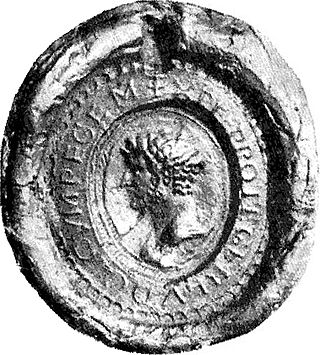
Louis the German, also known as Louis II of Germany and Louis II of East Francia, was the first king of East Francia, and ruled from 843 to 876 AD. Grandson of emperor Charlemagne and the third son of Louis the Pious, emperor of Francia, and his first wife, Ermengarde of Hesbaye, he received the appellation Germanicus shortly after his death, when East Francia became known as the kingdom of Germany.
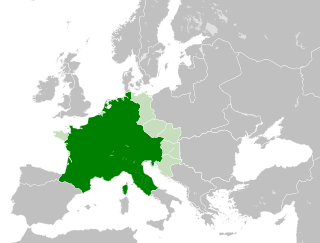
The Carolingian Empire (800–888) was a Frankish-dominated empire in Western and Central Europe during the Early Middle Ages. It was ruled by the Carolingian dynasty, which had ruled as kings of the Franks since 751 and as kings of the Lombards in Italy from 774. In 800, the Frankish king Charlemagne was crowned emperor in Rome by Pope Leo III in an effort to transfer the Roman Empire from the Byzantine Empire to Western Europe. The Carolingian Empire is considered the first phase in the history of the Holy Roman Empire.

Louis the Child, sometimes called Louis III or Louis IV, was the king of East Francia from 899 until his death and was also recognized as king of Lotharingia after 900. He was the last East Frankish ruler of the Carolingian dynasty. He succeeded his father, Arnulf, in East Francia and his elder illegitimate half-brother Zwentibold in Lotharingia.

Carloman I, also Karlmann, was king of the Franks from 768 until his death in 771. He was the second surviving son of Pepin the Short and Bertrada of Laon and was a younger brother of Charlemagne. His death allowed Charlemagne to take all of Francia and begin his expansion into other kingdoms.

Childeric III was King of the Franks from 743 until he was deposed in 751 by Pepin the Younger. He was the last Frankish king from the Merovingian dynasty. Once Childeric was deposed, Pepin became king, initiating the Carolingian dynasty.
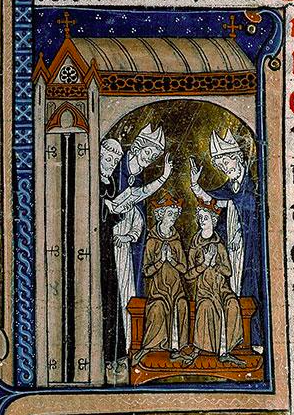
Carloman II was the King of West Francia from 879 until his death. A member of the Carolingian dynasty, he and his elder brother, Louis III, divided the kingdom between themselves and ruled jointly until the latter's death in 882. Thereafter Carloman ruled alone until his own death. He was the second son of King Louis the Stammerer and Queen Ansgarde.

Louis III was King of West Francia from 879 until his death in 882. He succeeded his father Louis the Stammerer, and ruled over West Francia in tandem with his brother Carloman II. Louis controlled the northern part of West Francia (Neustria), including the capital of Paris, while Carloman controlled the southern portion (Aquitania). Louis ruled from March 880 to 5 August 882, when he died and left the rest of West Francia to his brother. His short reign was profoundly influenced by his military success, including his defeating Vikings in August 881.
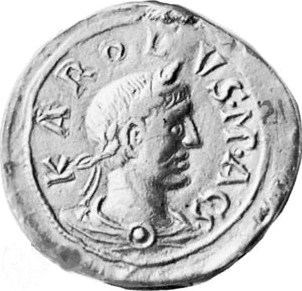
Charles III, also known as Charles the Fat, was the emperor of the Carolingian Empire from 881 to 888. A member of the Carolingian dynasty, Charles was the youngest son of Louis the German and Hemma, and a great-grandson of Charlemagne. He was the last Carolingian emperor of legitimate birth and the last to rule a united kingdom of the Franks.

The Kingdom of the Franks, also known as the Frankish Kingdom, the Frankish Empire or Francia, was the largest post-Roman barbarian kingdom in Western Europe. It was ruled by the Frankish Merovingian and Carolingian dynasties during the Early Middle Ages. Francia was among the last surviving Germanic kingdoms from the Migration Period era.

East Francia or the Kingdom of the East Franks was a successor state of Charlemagne's empire ruled by the Carolingian dynasty until 911. It was created through the Treaty of Verdun (843) which divided the former empire into three kingdoms.
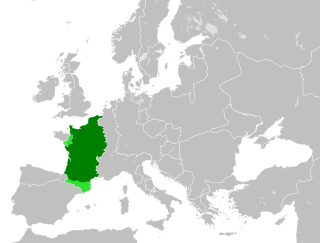
In medieval history, West Francia or the Kingdom of the West Franks refers to the western part of the Frankish Empire established by Charlemagne. It was the forerunner of the future Kingdom of France and existed from 843 to 987. West Francia emerged from the partition of the Carolingian Empire in 843 under the Treaty of Verdun following the death of Charlemagne's son, Louis the Pious.
Carloman was the youngest son of Charles the Bald, king of West Francia, and his first wife, Ermentrude. He was intended for an ecclesiastical career from an early age, but in 870 rebelled against his father and tried to claim a part of the kingdom as an inheritance.

The Ludwigslied is an Old High German (OHG) poem of 59 rhyming couplets, celebrating the victory of the Frankish army, led by Louis III of France, over Danish (Viking) raiders at the Battle of Saucourt-en-Vimeu on 3 August 881.
Adélaïde of Paris (Aélis) was a Frankish queen. She was the second wife of Louis the Stammerer, King of West Francia and mother of Charles the Simple.
The Battle of Thiméon was a Frankish victory over the Vikings near Thiméon north of the Sambre in February 880.
Louis the Younger, sometimes called Louis the Saxon or Louis III, was the second eldest of the three sons of Louis the German and Hemma. He succeeded his father as the King of Eastern Francia on 28 August 876 and his elder brother Carloman as King of Bavaria from 876 to 882. He died in 882 and was succeeded in all his territories, which encompassed most of East Francia, by his younger brother, Charles the Fat, already king of Italy and emperor.

Louis II, known as Louis the Stammerer, was the king of Aquitaine and later the king of West Francia. He was the eldest son of Emperor Charles the Bald and Ermentrude of Orléans. Louis the Stammerer was physically weak and outlived his father by a year and a half.

The Treaty of Ribemont in 880 was the last treaty on the partitions of the Frankish Empire. It was signed by the German king Louis the Younger and the kings of Western Francia, Louis III and Carloman.
George was a Franco-papal diplomat who served as the bishop of Ostia (753–798) in the Papal State and bishop of Amiens (767–798) in Francia. He moved extensively between Italy and Francia, but his best recorded mission is the one he made to England in 786.
50°06′15″N1°36′57″E / 50.1042°N 1.6158°E